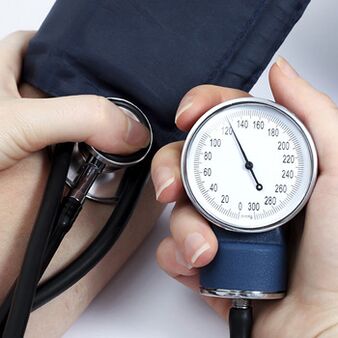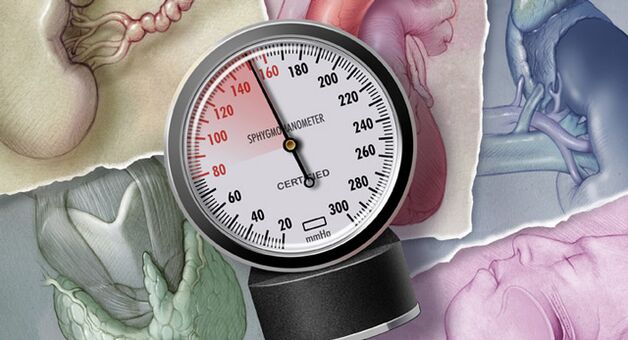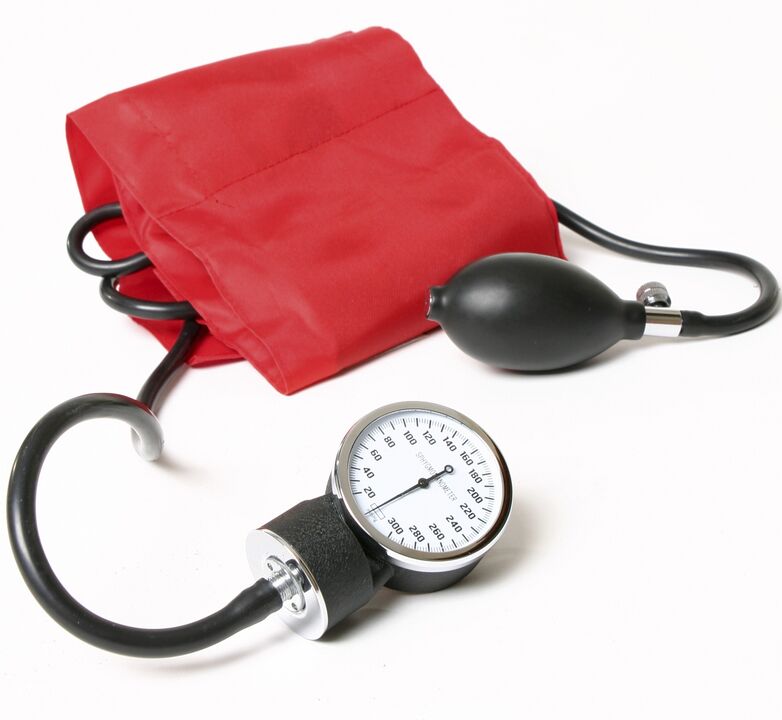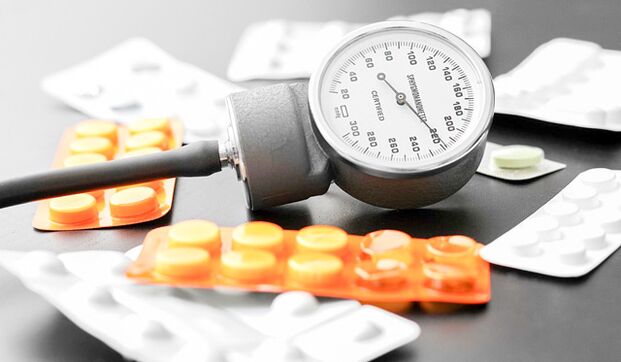
Hypertension (HTN) is one of the most common diseases of the cardiovascular system, which only affects the third residents in terms of approximate data.By 60-65 years, more than half of the population was diagnosed with hypertension.The disease is called "silent killers", because his signs can be absent long, while changes in the walls of blood vessels begin already in the asymptomatic phase, greatly increasing the risk of vascular accidents.
In western literature, the disease is called arterial hypertension (AH).Others adopted this formulation, although "hypertension" and "hypertension" are still in common use.
Zabrno's attention to the problem of arterial hypertension does not cause as many clinical events as complications in the form of acute vascular disorders in the brain, heart and kidneys.Their prevention is the main goal of treatment focused on maintaining normal blood pressure (BP).
It is important to identify all possible risk factors,as well as clarifying their role in progressing the disease.The relationship between the degree of hypertension and existing risk factors is shown in the diagnosis, which simplifies the assessment of the patient and forecast.
For most patients, numbers in diagnostics after "Ah" do not mean anything, although it is clear that the higher the point and indicator of risk, above forecast and more serious pathology.In this article, we will try to understand how and why one or the second degree of hypertension is diagnosed and what basically determining the risk of complicates.
Causes and risk factors Hypertension
The causes of arterial hypertension are numerous.GovSpeaking of primary or essential, hypertension, we andWe mean the case when there is no specified previous illness or pathology of internal organs.In other words, such hypertension occurs independently, including other bodies in the pathological process.Primary hypertence makes up more than 90% of cases of chronic high blood pressure.
The main cause of primary hypertension is considered stress and psycho-emotional overload, which contribute to the disruption of central mechanisms in the brain, then suffer in humorist mechanisms, and the target bodies are involved (kidneys, heart, retina).

Secondary hypertension- Manifestation of another pathology, so its cause is always known.Follow the kidney disease, hearts, brains, endocrine disorders and are secondary to them.After the cure of a fundamental disease, hypertension is also going away, so it doesn't make sense to determine the risk and degree in this case.Symptomatic hypertension makes no more than 10% of cases.
The risk factors for hypertension are also known to everyone.Hypertension schools are created in clinics, whose experts are transferring information to the population of unfavorable conditions leading to hypertension.Each therapist or cardiologist will tell the patient on the risks already in the first case of recorded high blood pressure.
Among the conditions that predispose the hypertension, the most important are:
- Smoking;
- Excess salt in food, excessive fluid intake;
- Insufficient physical activity;
- Alcohol abuse;
- Excess disorder of the metabolism of weight and fat;
- Chronic psycho-emotional and physical overload.
If we can exclude the listed factors or at least try to reduce their impact on health, then such characteristics as sex, age, heredity cannot be changed, and that is why we will have to be placed with them, but not forgetting the growing risk.
Classification of arterial hypertension and risk level determination
The classification of hypertension includes the identification of the stage, disease degree and level of risk of vascular accidents.
Disease phaseDepends on clinical events.Mark:
- Proclining phase, when there are no signs of hypertension, and the patient is unaware of blood pressure increases;
- Phase 1 hypertension, when the pressure is raised, the crisis are possible, but there are no signs of damage from the target organ;
- Phase 2 monitors the damage to the target bodies - myocardial hypertrophy, changes in the retinal eyes are noticeable, and the kidneys suffer;
- In phase 3, strokes, myocardial ischemia, vision pathology, changes in large vessels (aortic aneurysms, atherosclerosis) are possible.
Degree of hypertension
Determining the degree of hypertension is important in the risk assessment and forecast and is based on pressure data.It must be said that normal blood pressure values also have different clinical significance.Thus, the indicator is up to 120/80 mm Hg.Art.countoptimal,normalThe pressure will be between 120-129 mmHg.Art.Systolic and 80-84 mm Hg.Art.diastolic.Pressure numbers 130-139 / 85-89 mmHg.Art.still lie within normal boundaries, but the boundary with pathology is approaching, which is why they are called "very normal"And the patient can be said to have a high normal blood pressure. These indicators can be considered a pathology, because the pressure is only" a few millimeters ".

From the moment the blood pressure reached 140/90 mm Hg.Art.We can already discuss the presence of the disease.This indicator is used to determine the degree of hypertension itself:
- 1. The degree of hypertension (HTN or AH 1. phase in diagnostics) means increasing pressure in the range of 140-159 / 90-99 mm Hg.Art.
- Headache on stage 2 Follow numbers 160-179 / 100-109 mmHg.Art.
- With phase 3 hypertension, the pressure is 180/100 mmHg.Art.And higher.
This happens to reinforce the figures with systolic pressure, in the amount of 140 mm Hg.Art.and higher, while the diastolic value is within normal values.In this case they talk aboutisolated systolic formHypertension.In other cases, the indicators of systolic and diastolic pressure correspond to different degrees of disease, then the doctor makes the diagnosis in favor of a greater extent, and it does not matter whether the conclusions are drawn on a systolic or diastolic pressure.
The most accurate diagnosis of the degree of hypertension is possible when the disease is first diagnosed, when treatment has not yet been implemented, and the patient did not take any antihypertensive drugs.During the therapy, the numbers fall, and when interrupted, on the contrary, they can increase abruptly, so that it is no longer possible to adequately assess the degree.
Risk concept in the diagnosis
Hypertension is dangerous because of its complications.It is not a secret that the vast majority of patients die or disabled not from the fact of high blood pressure, but from acute disorders he leads.
Cerebral bleeding or ischemic necrosis, myocardial infarction, kidney failure are the most dangerous conditions that provocate high blood pressure.In this regard, for each patient after a fundamental examinationThe risk is determined, indicated in diagnosis of numbers 1, 2, 3, 4. is diagnosed based on the degree of hypertension and risk of vascular complications (for example, hypertension / hypertension 2).
Risk stratification criteriaFor patients with hypertension, external conditions, the presence of other diseases and metabolic disorders, involvement of target bodies and simultaneous changes in bodies and systems.
The main risk factors that affect the forecast include:
- The age of the patient is after 55 years for men and 65 for women;
- Smoking;
- Lipid metabolism disorders (crossing the Norma cholesterol, low density lipoprotein, reduced high density lipid fractions);
- The presence of cardiovascular pathology in the family among blood relatives under 65 and 55 years for women and males;
- Excess body weight, when the abdomen circumference exceeds 102 cm in men and 88 cm in women.
These factors are considered main, but many patients suffer from diabetes, damaged glucose tolerance, water sitting and having abnormality in the blood system in the form of fibrinogen concentration.These factors consideradditional, also increasing the likelihood of complications.
Damage to target bodies is characterized by hypertension, starting from phase 2, and serve as an important criterion determining the risk, therefore, test the patient Ultra ultrasound for blood and urine tests (creatinine, protein).
First of all, the heart suffers from high blood pressure, which pushes the blood into the vessels with increased force.As arteries and arterioles change, when their walls lose elasticity, and lumens become spasmodic, heart load gradually increases.Characteristic characteristic taken into account when considering stratified riskMyocardial hypertrophy, which can be suspected for ECG, can be determined by ultrasound examination.
The involvement of the kidneys as a target body is marked by increasing creatinins in the blood and urine and the appearance of protein albumin in urine.Against the background of hypertension, the walls of large arteries look, atherosclerotic plaques appear that can be discovered by ultrasound (carotide, braciophalic arteries).
The third phase of hypertension occurs with the corresponding pathology, ie associated with hypertension.Among related diseases, the most important are for the forecast, transient ischemic attacks, heart attack and angina, nephropathy due to diabetes, renal failure, retinopathies) due to hypertension.
So, the reader probably understand how you can even independently determine the degree of headaches.This is not difficult, you just need to measure pressure.Further, you can think about the presence of certain risk factors, consider age, gender, laboratory parameters, ECG data, ultrasound, etc.Generally, everything that is all of the above.
For example, the patient's comic blood pressure corresponds to the hypertension on 1. site, but at the same time suffered a stroke, which means that the risk will be maximum - 4, even if the brainer is the only problem except hypertension.If the pressure corresponds to the first or second degree, and the only risk factors that can be noticed smoke and the age of the background of quite good health, and then the risk will be moderate - 1 tablespoon.(2 tbsp), risk 2.
To make more clearly what the risk indicator in diagnostics means you can summarize everything in a small table.By determining the diploma and "counting" the above factors, you can determine the risk of vascular accidents and complications of hypertension for a particular patient.Number 1 means low risk, 2 - moderate, 3 - high, 4 - very high risk of complications.
| Risk factors | BP 130-139 / 85-89, Risk | GB (AH) 1, Risk | GB 2, risk | HR 3, Risk |
|---|---|---|---|---|
| none | 1 | 2 | 3 | |
| 1-2 | 1 | 2 | 2 | 4 |
| More than three factors / targeted damage / diabetes | 3 | 3 | 3 | 4 |
| Related pathology | 4 | 4 | 4 | 4 |
Low risk means that the probability of vascular accidents is no more than 15%, a high-risk indicate the development of complications in a third of patients from this group, with very high risk, more than 30% of patients are subject to complications.
Events and complications of headaches
The manifestations of hypertension are determined by the disease phase.In the praise period, the patient feels well, and only tonometer readings indicate disease in development.

As changes in blood vessels and heart progress, symptoms appear in the form of headaches, weaknesses, reduced performance, periodic dizziness, visual symptoms in the form of weakened vision sharpness, blinking "spots" before the eyes.All these signs are not expressed during the stable flow of pathology, but at the time of the development of a hypertensive crisis, the clinic becomes brighter:
- Strong headache;
- Noise, ringing in head or ears;
- Blackout in the eyes;
- Heartache;
- Dyspnea;
- Hyperemia on his face;
- The excitement and feeling of fear.
Hypertensive crises provoke traumatic situations, excessive work, stress, consumption of coffee and alcoholic beverages, so patients with already established diagnosis should avoid such influences.Against the background of the hypertensive crisis, the likelihood of complications increasing abruptly, including life-threatening:
- Hemorrhage or cerebral infarction;
- Acute hypertensive encephalopathy, possibly with cerebral edema;
- Pulmonary edema;
- Acute kidney failure;
- Heart attack.
How to properly measure blood pressure?
If there is a reason to doubt high blood pressure, the first thing the specialist will do is measure.Until recently, blood pressure numbers were believed to be normally distinguished in different hands, but, as in the practice shown, even the difference of 10 mm Hg.Art.It can occur due to the pathology of peripheral vessels, so different pressures on the right and left hand should be treated with caution.

To obtain the most reliable figures, it is recommended to measure pressure three times on each hand with short time intervals, recording each resulted result.In most patients, values obtained mostly the values obtained, but in some cases, the pressure increases from measurement to measure, which does not always speak in favor of hypertension.
Large selection and availability of blood pressure measuring devices allow it to monitor in a wide range of people at home.Typically, hypertensive patients have a tonometer at home, at hand, so if their health is getting worse, they can immediately measure blood pressure.It is worth noting that fluctuations are also possible in absolutely healthy individuals without hypertension, so that one surplus norm should not be considered disease and to diagnose hypertension, the pressure must be measured at different times, in different conditions and repeatedly.
When diagnosing hypertension, blood pressure data, electrocardiographies and heartbreaker auscultation results are considered fundamental.When you listen, it is possible to discover noise, increased tones and arrhythmias.ECG, starting from the second phase, will show signs of stress on the left side of the heart.
Hypertension treatment
In order to correct high blood pressure have developed treatment modes that include drugs of different groups and different mechanisms of action.TheirThe combination and dosing chooses a doctor individuallyTaking into account the stage, simultaneous pathology and the response of hypertension on a particular drug.After making a diagnosis of hypertension, and before starting drug treatment, the doctor will suggest no drugs that significantly increase pharmacological drugs, and sometimes allow you to reduce the dose of medications or leave at least some of them.
First of all, the normalization of the regime is recommended, eliminate stress and ensure physical activity.The diet is focused on reducing salt and liquid intake, eliminating alcohol, coffee and drinks and substances that encourage the nervous system.If you have excess weight, you should restrict calories and avoid oily, fush, fried and spicy food.
Drug-free measures in the initial phase of hypertension can have such a good effect that the need to prescribe medications will no longer be needed.If these measures do not work, the doctor prescribes appropriate medications.
The goal of hypertension treatment is not just a reduction in blood pressure, but also for removal, if possible, its cause.

Antihypertensive medications from the following groups are traditionally used to treat hypertension:
- Diuretics;
- Angiotensin II receptor antagonists;
- ACE inhibitors;
- Adrenergic blockers;
- Kalcium channel blockers.
Each year list of drugs that reduce blood pressure is growing at the same time becomes more efficient and safer, with less unwanted reactions.During the initial therapy, one drug prescribed by a minimum dose;If inefficiently, it can be increased.If the disease is progressing and the pressure does not remain in acceptable values, another drug from another group is added to the first medicine.Clinical observations show that the effect is better with combined therapy than with the prescribing of one medicine in the maximum amount.
Reducing the risk of vascular complications is important in choosing treatment mode.It was therefore noted that some combinations have a more pronounced "protective" effect on the authorities, while others allow better pressure control.In such cases, experts prefer a combination of drugs that reduce the likelihood of complications, even if there are daily fluctuations in blood pressure.
In some cases, it is necessary to take into account the same time pathology, which adjusts the headache treatment regimens.For example, men with prostate adenoma are prescribed by alpha blockers, which are not recommended for continuous use to reduce blood pressure in other patients.
Most commonly used ACE inhibitors, calcium channel blockers,Who are prescribed both young and older patients, with or without simultaneous diseases, diuretics, sartons.Medications in these groups are suitable for initial treatment, which can then be supplemented by a third drug of different compositions.
ACE inhibitors reduce blood pressure and at the same time have a protective effect on the kidneys and myokard.They are desirable in young patients, women who take hormonal contraceptives, indicated for diabetes and for older patients.
DiuretikaNot even less popular.In order to reduce unwanted reactions, they combine with ACE inhibitors, sometimes "in one tablet."
Beta BlockersThey are not a priority hypertension group, but are effective for concurrent heart pathology - heart failure, tachycardia, coronary disease.
Channel calcium blocksOften prescribed in combination with ACE inhibitors, they are especially good for bronchial asthma in combination with hypertension, because they do not cause bronchospasm.
Angiotenzina receptor antagonists- The most appropriately group of hypertension drugs.They effectively reduce blood pressure and do not cause cough as many ACE inhibitors.But in America are especially jointly due to a reduction of 40% at risk of Alzheimer's disease.
When treating hypertension, it is important not only to choose an effective mode, but also for a long time taking drugs, even for life.Many patients believe that when pressure reaches normal levels, treatment can be stopped, but installed tablets until the time of the crisis.It is known that the unsystematic use of antihypertensive drugs is even more harmful to health than the complete lack of treatment, so the patient's information is about to treat the doctor's important tasks.























